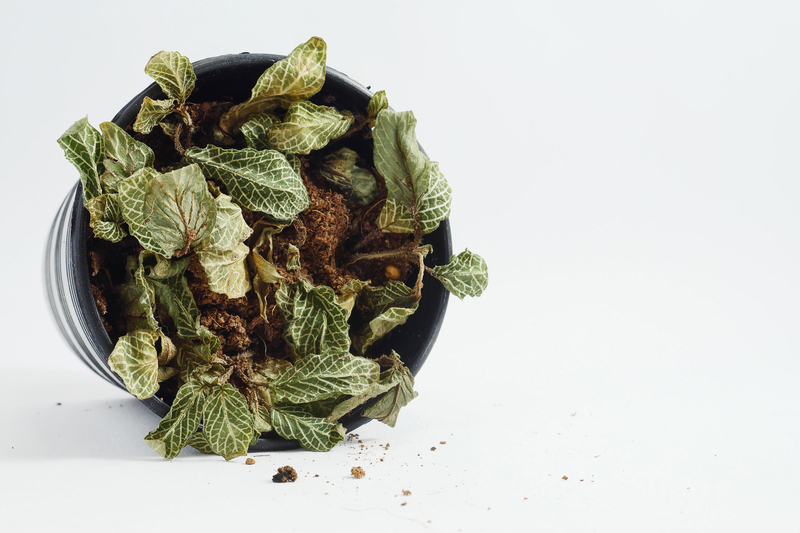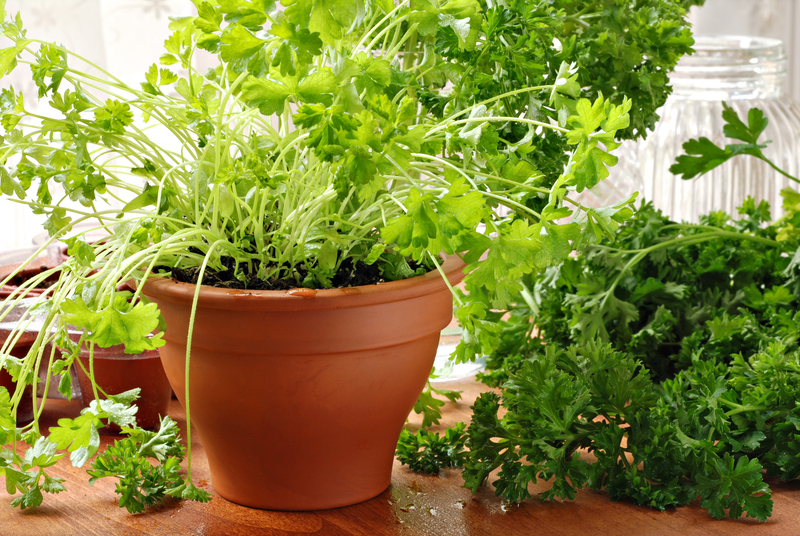Building a Lush, Green Herb Escape in Simple Steps
Posted on 12/06/2025
Building a Lush, Green Herb Escape in Simple Steps: Your Ultimate Guide
Imagine stepping outside or waking up to the enticing aroma and vibrant green hues of a flourishing herb garden. Creating your very own herb-filled paradise isn't as complicated as it may seem. Whether you have acres of land or a sunny windowsill, building a lush, green herb escape is accessible to everyone. This comprehensive guide will walk you through every stage, from planning and planting to nurturing and harvesting your thriving herb oasis--all simplified into actionable steps for gardeners of any experience level.

Why Create Your Own Green Herb Hideaway?
- Year-Round Fresh Herbs: Enjoy culinary creativity and enhanced flavors with your own supply.
- Sustainable and Organic: Control what goes into your soil and onto your plate.
- Therapeutic Benefits: Gardening is proven to reduce stress, improve mood, and connect you with nature.
- Aesthetic Appeal: Green, leafy herbs create a beautiful, calming space indoors or outdoors.
With just a bit of planning and attention, you can transform any space into a verdant herb sanctuary. Here's how:
Step 1: Plan Your Herb Garden Escape
Analyze Your Space and Conditions
First, consider where you want your green herb retreat to flourish. The key elements for success are:
- Sunlight: Most herbs need 6-8 hours of sun daily. Observe where light falls in your yard, balcony, or windowsill.
- Wind and Weather: If outdoors, select a spot protected from strong winds and heavy rainfall.
- Accessibility: Place your herb zone where you can see, smell, and easily harvest it--close to your kitchen is ideal!
- Soil Drainage: Ensure soil isn't waterlogged; raised beds or large containers work well if drainage is an issue.
Choose Your Herb Selection
Think about your cooking preferences, fragrance, and desired look. Try these proven herbs:
- Basil: For Italian and Asian dishes, grows quickly in warmth.
- Parsley: Flat-leaf or curly; a garnish essential.
- Mint: Refreshing and easy--great in drinks and desserts.
- Rosemary: Aromatic and evergreen; loves sun and well-drained soil.
- Thyme: Hardy and versatile with gentle fragrance.
- Cilantro: Vital for salsas, curries, and salads.
- Chives, sage, oregano, dill, and tarragon also make excellent, easy additions to any lush herb paradise.
Design Your Green Retreat
Plan the layout to balance practicality and beauty:
- Cluster contrasting textures and heights (tall rosemary behind, trailing thyme at the edges).
- Mix edible flowers like nasturtiums or calendula for color and pollinators.
- Consider themed gardens: pizza herbs, tea blends, Mediterranean flavors, or a medicinal apothecary garden.
Step 2: Gather Supplies and Prepare Your Growing Site
Select the Right Containers or Beds
For a robust green herb sanctuary, pick containers or beds with these qualities:
- Good drainage holes--herbs dislike soggy roots.
- Material to match your climate: terra cotta for breathability, resin for lightness, raised beds for volume.
- Depth of 6-12 inches suffices for most culinary herbs.
Invest in High-Quality Soil
Your lush, green herb retreat starts with healthy, loose soil:
- Use a premium organic potting mix or amend garden beds with well-rotted compost.
- Add perlite or coarse sand for enhanced drainage.
- Test the pH (most herbs prefer 6.0-7.0)--adjust with lime for acidity or sulfur for alkalinity.
Essential Tools for Herb Gardening
Gather these basic tools to streamline your planting process:
- Hand trowel and cultivator for digging and mixing soil
- Pruning shears for harvesting and shaping
- Watering can with fine rose for gentle watering
- Labels or stakes to identify herbs while young
- Organic mulch or straw to help lock in soil moisture and stave off weeds
Step 3: Planting for Success
Start From Seed or Seedling?
- Seeds: Offer the most variety and savings; start indoors 4-8 weeks before the last frost.
- Seedlings: Fast-track your garden. Perfect for beginners or those impatient for results.
How to Plant Herbs Effectively
- Space appropriately: Allow 6-12 inches between different species for airflow and growth.
- Plant at the same depth as in the pot or cell-tray--the exception is basil, which can be slightly deeper for stronger stems.
- Water upon planting, ensuring the soil is moist, but not saturated.
- Add a layer of organic mulch to retain moisture, suppress weeds, and keep roots cool.
Step 4: Tending Your Lush Herb Paradise
Water Wisely
Herbs prefer even, consistent moisture, but hate soggy roots. Follow these guidelines:
- Water in the morning--the sun helps leaves dry, preventing disease.
- Check soil moisture with a finger two inches down; water only if dry at this depth.
- Use drip irrigation or soaker hoses for larger beds.
- During hot, dry spells, increase watering frequency--but always avoid waterlogging.
Feeding Your Green Refuge
- Go easy on fertilizer: Too much can lead to less flavorful leaves.
- Feed every 4-6 weeks with a balanced organic fertilizer or compost tea.
- Yellow leaves indicate excessive nutrients or poor drainage.
Pruning, Pinching, and Harvesting
- Regular harvesting stimulates new leaf growth and keeps herbs bushy.
- Pinch soft-stemmed herbs (e.g., basil, mint) just above a leaf node.
- Cut back woody herbs (like rosemary, thyme) by up to a third in late spring to maintain shape.
- Remove flower buds promptly to prolong leaf production (unless you're saving seeds).
Pest and Disease Management
- Promote biodiversity--mix in flowers to attract beneficial insects like ladybugs.
- Regular inspection helps spot early signs of aphids, mites, or fungal spots.
- Spray with a gentle soap solution or neem oil for non-toxic pest control.
- Avoid overhead watering to minimize foliar diseases.
Step 5: Enjoying and Expanding Your Herb Escape
Creative Ways to Use Your Herbs
- Culinary: Chop fresh parsley, basil, or chives into salads, sauces, and pasta for a flavor boost.
- Drinks: Muddle mint or basil into cocktails and teas for a refreshing twist.
- Health: Steep chamomile or lemon balm for calming herbal teas.
- Decor: Let potted herbs double as fragrant centerpieces indoors or on patios.
- Homemade Gifts: Create infused oils, vinegars, or herbal sachets for friends and family.
Seasonal Care and Preservation
Maximize your herb garden's green bounty year-round:
- Dry or freeze surplus leaves for winter use.
- Move potted herbs indoors or grow on windowsills to extend the season.
- Divide larger perennial herbs in spring to propagate and expand your patch.
- Rejuvenate annuals each year by reseeding or replacing spent plants.
Step 6: Troubleshooting Common Herb Garden Challenges
Why Are My Herbs Leggy or Weak?
- Not enough light: Move to where herbs receive more sun.
- Crowding: Thin seedlings; never let plants compete for resources.
- Overfeeding: Cut back on fertilizer--herbs thrive in slightly lean soil.
Dealing with Leaf Drop or Yellowing
- Watering issues: Both under- and over-watering cause stress--adjust based on weather and season.
- Inspect roots for rot if symptoms persist. Repot in fresh, airy soil if needed.
Pest Invasions
- Encourage natural predators with pollinator-friendly flowers nearby.
- Manually remove aphids or mites with a gentle wash.
- Rotate stored soil and avoid reusing contaminated pots between seasons.

Simple Tips for a Thriving Green Herb Sanctuary
- Label everything! Young herbs often look similar--labels prevent confusion and accidental harvesting.
- Mix annual and perennial herbs for continuous harvest and long-term beauty.
- Try vertical gardening or stacking containers to maximize small spaces.
- Rotate container positions for even growth if sunlight direction shifts with seasons.
- Take notes: Track successes and failures to refine your herb gardening techniques year by year.
Conclusion: Cultivate Your Own Lush, Green Herb Getaway--Simply
Whether you dream of a sprawling backyard retreat or a cozy kitchen windowsill of thriving greenery, building a lush, green herb escape is wonderfully achievable. With mindful planning, organic care, and a dash of creativity, you'll soon enjoy the beauty, flavor, and soothing power that only fresh herbs deliver. Embark on your herb gardening adventure today, and in just a few simple steps, you'll cultivate not just plants--but a personal, verdant haven of happiness.
Ready to start your herb escape? Gather your seeds, roll up your sleeves, and discover the joy of a lush, green herb paradise--one satisfying step at a time!

